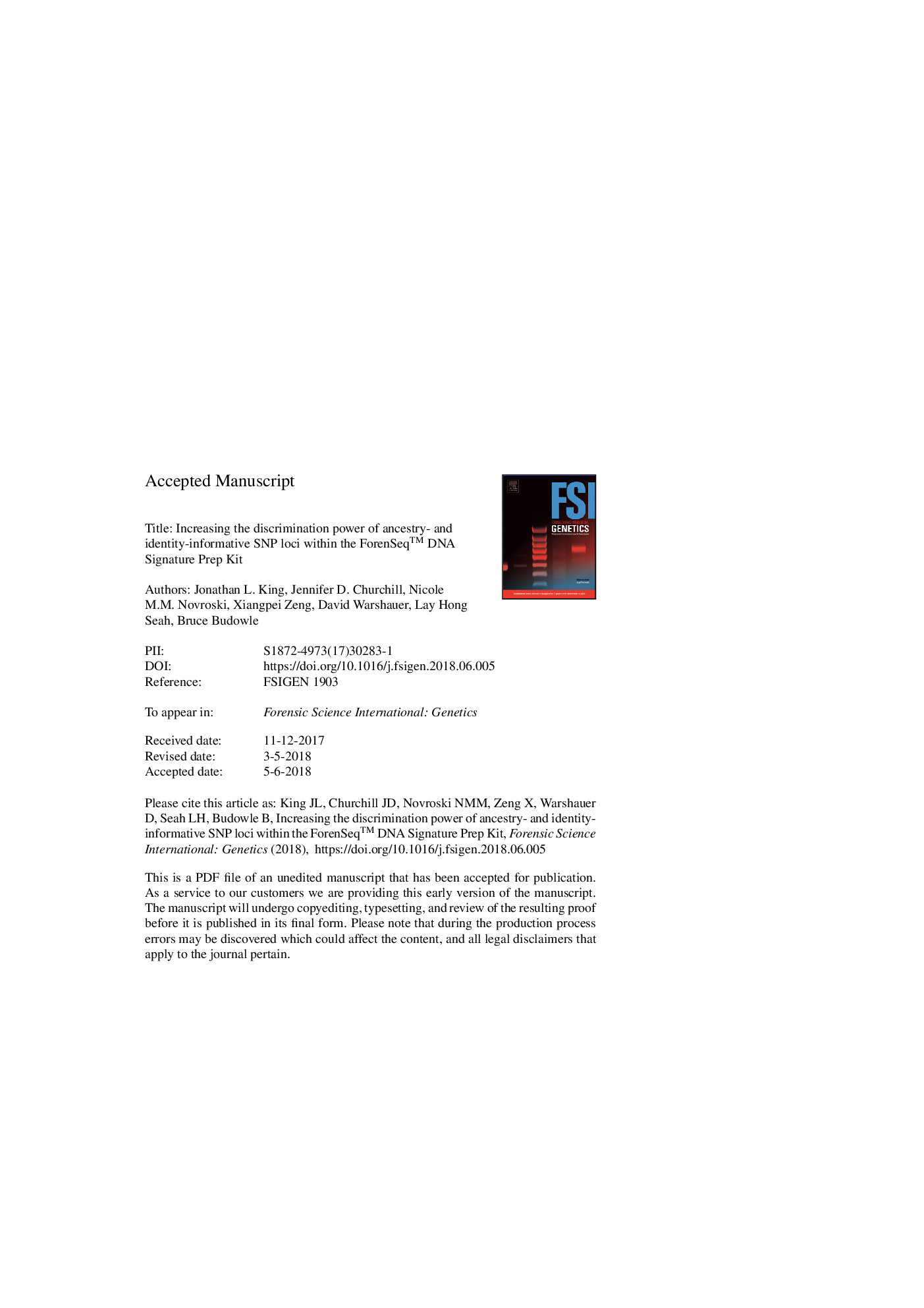| کد مقاله | کد نشریه | سال انتشار | مقاله انگلیسی | نسخه تمام متن |
|---|---|---|---|---|
| 6553187 | 1422142 | 2018 | 28 صفحه PDF | دانلود رایگان |
عنوان انگلیسی مقاله ISI
Increasing the discrimination power of ancestry- and identity-informative SNP loci within the ForenSeq⢠DNA Signature Prep Kit
دانلود مقاله + سفارش ترجمه
دانلود مقاله ISI انگلیسی
رایگان برای ایرانیان
کلمات کلیدی
موضوعات مرتبط
علوم زیستی و بیوفناوری
بیوشیمی، ژنتیک و زیست شناسی مولکولی
ژنتیک
پیش نمایش صفحه اول مقاله

چکیده انگلیسی
The use of single nucleotide polymorphisms (SNPs) in forensic genetics has been limited to challenged samples with low template and/or degraded DNA. The recent introduction of massively parallel sequencing (MPS) technologies has expanded the potential applications of these markers and increased the discrimination power of well-established loci by considering variation in the flanking regions of target loci. The ForenSeq Signature Preparation Kit contains 165 SNP amplicons for ancestry- (aiSNPs), identity- (iiSNPs), and phenotype-inference (piSNPs). In this study, 714 individuals from four major populations (African American, AFA; East Asian, ASN; US Caucasian, CAU; and Southwest US Hispanic, HIS) previously reported by Churchill et al. [Forensic Sci Int Genet. 30 (2017) 81-92; DOI: https://doi.org/10.1016/j.fsigen.2017.06.004] were assessed using STRait Razor v2s to determine the level of diversity in the flanking regions of these amplicons. The results show that nearly 70% of loci showed some level of flanking region variation with 22 iiSNPs and 8 aiSNPs categorized as microhaplotypes in this study. The heterozygosities of these microhaplotypes approached, and in one instance surpassed, those of some core STR loci. Also, the impact of the flanking region on other forensic parameters (e.g., power of exclusion and power of discrimination) was examined. Sixteen of the 94 iiSNPs had an effective allele number greater than 2.00 across the four populations. To assess what effect the flanking region information had on the ancestry inference, genotype probabilities and likelihood ratios were determined. Additionally, concordance with the ForenSeq UAS and Nextera Rapid Capture was evaluated, and patterns of heterozygote imbalance were identified. Pairwise comparison of the iiSNP diplotypes determined the probability of detecting a mixture (i.e., observing ⥠3 haplotypes) using these loci alone was 0.9952. The improvement in random match probabilities for the full regions over the target iiSNPs was found to be significant. When combining the iiSNPs with the autosomal STRs, the combined match probabilities ranged from 6.40â¯Ãâ¯10â73 (ASN) to 1.02â¯Ãâ¯10-79 (AFA).
ناشر
Database: Elsevier - ScienceDirect (ساینس دایرکت)
Journal: Forensic Science International: Genetics - Volume 36, September 2018, Pages 60-76
Journal: Forensic Science International: Genetics - Volume 36, September 2018, Pages 60-76
نویسندگان
Jonathan L. King, Jennifer D. Churchill, Nicole M.M. Novroski, Xiangpei Zeng, David H. Warshauer, Lay-Hong Seah, Bruce Budowle,